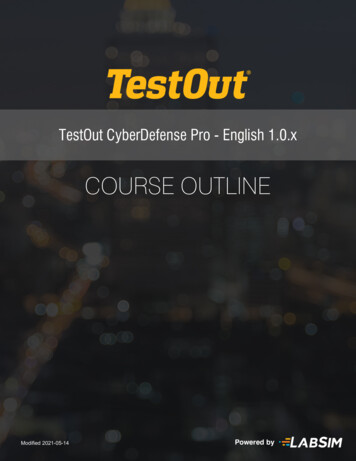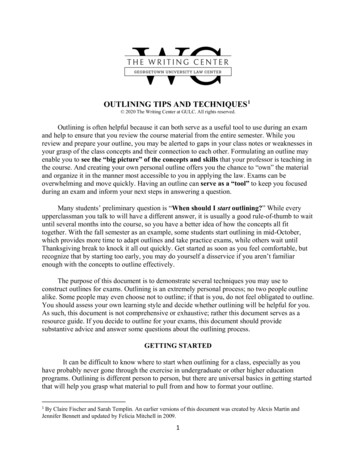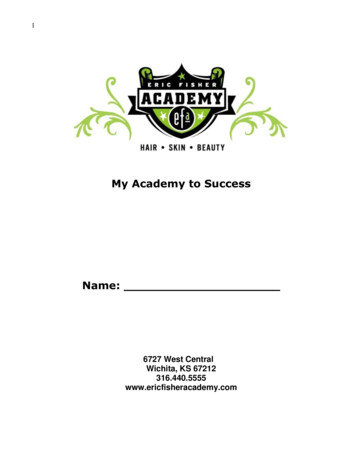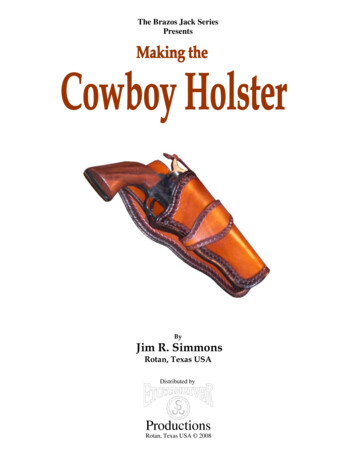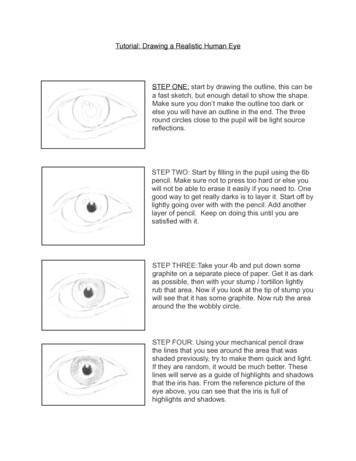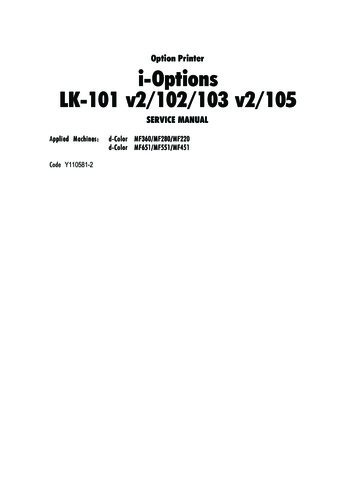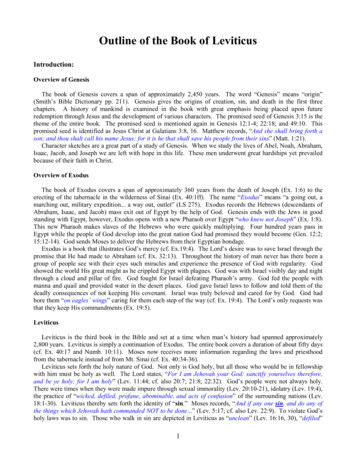
Transcription
Outline of the Book of LeviticusIntroduction:Overview of GenesisThe book of Genesis covers a span of approximately 2,450 years. The word “Genesis” means “origin”(Smith’s Bible Dictionary pp. 211). Genesis gives the origins of creation, sin, and death in the first threechapters. A history of mankind is examined in the book with great emphasis being placed upon futureredemption through Jesus and the development of various characters. The promised seed of Genesis 3:15 is thetheme of the entire book. The promised seed is mentioned again in Genesis 12:1-4; 22:18; and 49:10. Thispromised seed is identified as Jesus Christ at Galatians 3:8, 16. Matthew records, “And she shall bring forth ason; and thou shalt call his name Jesus; for it is he that shall save his people from their sins” (Matt. 1:21).Character sketches are a great part of a study of Genesis. When we study the lives of Abel, Noah, Abraham,Isaac, Jacob, and Joseph we are left with hope in this life. These men underwent great hardships yet prevailedbecause of their faith in Christ.Overview of ExodusThe book of Exodus covers a span of approximately 360 years from the death of Joseph (Ex. 1:6) to theerecting of the tabernacle in the wilderness of Sinai (Ex. 40:1ff). The name “Exodus” means “a going out, amarching out, military expedition. a way out, outlet” (LS 275). Exodus records the Hebrews (descendants ofAbraham, Isaac, and Jacob) mass exit out of Egypt by the help of God. Genesis ends with the Jews in goodstanding with Egypt, however, Exodus opens with a new Pharaoh over Egypt “who knew not Joseph” (Ex. 1:8).This new Pharaoh makes slaves of the Hebrews who were quickly multiplying. Four hundred years pass inEgypt while the people of God develop into the great nation God had promised they would become (Gen. 12:2;15:12-14). God sends Moses to deliver the Hebrews from their Egyptian bondage.Exodus is a book that illustrates God’s mercy (cf. Ex.19:4). The Lord’s desire was to save Israel through thepromise that He had made to Abraham (cf. Ex. 32:13). Throughout the history of man never has there been agroup of people see with their eyes such miracles and experience the presence of God with regularity. Godshowed the world His great might as he crippled Egypt with plagues. God was with Israel visibly day and nightthrough a cloud and pillar of fire. God fought for Israel defeating Pharaoh’s army. God fed the people withmanna and quail and provided water in the desert places. God gave Israel laws to follow and told them of thedeadly consequences of not keeping His covenant. Israel was truly beloved and cared for by God. God hadbore them “on eagles’ wings” caring for them each step of the way (cf. Ex. 19:4). The Lord’s only requests wasthat they keep His commandments (Ex. 19:5).LeviticusLeviticus is the third book in the Bible and set at a time when man’s history had spanned approximately2,800 years. Leviticus is simply a continuation of Exodus. The entire book covers a duration of about fifty days(cf. Ex. 40:17 and Numb. 10:11). Moses now receives more information regarding the laws and priesthoodfrom the tabernacle instead of from Mt. Sinai (cf. Ex. 40:34-36).Leviticus sets forth the holy nature of God. Not only is God holy, but all those who would be in fellowshipwith him must be holy as well. The Lord states, “For I am Jehovah your God: sanctify yourselves therefore,and be ye holy; for I am holy” (Lev. 11:44; cf. also 20:7; 21:8; 22:32). God’s people were not always holy.There were times when they were made impure through sexual immorality (Lev. 20:10-21), idolatry (Lev. 19:4),the practice of “wicked, defiled, profane, abominable, and acts of confusion” of the surrounding nations (Lev.18:1-30). Leviticus thereby sets forth the identity of “sin.” Moses records, “And if any one sin, and do any ofthe things which Jehovah hath commanded NOT to be done.” (Lev. 5:17; cf. also Lev. 22:9). To violate God’sholy laws was to sin. Those who walk in sin are depicted in Leviticus as “unclean” (Lev. 16:16, 30), “defiled”1
(Lev. 18:30), “impure” (Lev. 22:21), and having a “blemish or imperfection” (Lev. 22:21). The holy nature ofGod is depicted in His “abhorrence” of those who walk in sin (cf. Lev. 20:23).Furthermore, we discover the perfect and holy nature in God when reading of the requirements of those whowould serve as priests at Leviticus 16. No son of Aaron who had a blemish in that he was blind, was lame, hada flat nose, was deformed, had a broken foot or hand, had a crooked back, was a dwarf, had an eye malady, orhad injured testicles could serve as priest. Such a one was viewed as “blemished” (Lev. 21:18-21). God’sholiness is fixed in our minds when we read of the defiled state of these blemished sons of Aaron, those who hadleprosy, women who delivered babies, and even those who were in a menstrual cycle. These people did noblatant sin, yet they were depicted as unclean for set periods due to the holy nature of God.The Lord provided His people with the means whereby they could be sanctified and holy rather than leavingthem hopeless. Some have thereby termed the book of Leviticus “A handbook for priests.” Speaking of theprohibition of one eating blood, the Lord states, “For the life of the flesh is in the blood; and I have given it toyou upon the altar to make atonement for your souls: for it is the blood that makes atonement by reason of thelife” (Lev. 17:11). Moses is instructed to give the people the laws of sacrifices so that they may be atoned oftheir sin. There were burnt-offerings, meal-offerings, and peace-offerings. Burnt-offerings would beunblemished bullocks, sheep, goats, turtle-doves, and or pigeons depending upon the individual’s economicstanding. These burnt-offerings would serve to atone man of sin (Lev. 4:3ff) and trespasses (Lev. 5:6). Thosewho brought these sacrifices before Jehovah were “confessing their sin” and illustrating a heart that desired Hismercy and forgiveness (cf. Lev. 5:5; 26:40). Those who refused to follow God’s commands in these areas wereto be put out of the camp of Israel (cf. Numb. 15:30).The importance of keeping God’s commandments is firmly fixed in the book of Leviticus. Moses writes,“Sanctify yourselves therefore, and be ye holy; for I am Jehovah your God. And ye shall keep my statutes, anddo them: I am Jehovah who sanctifies you” (Lev. 20:7-8; cf. also 18:4, 30; 20:22; 22:31). To do those things inwhich God has not commanded is sin, and the Lord does not take lightly such actions. Nadab and Abihu standout as an ever horrifying reminder as to what it means to fall into the hands of the living God for disobedience.These two sons of Aaron offered “strange fire” to Jehovah and were consumed by God because it was notsomething that He “commanded them” (Lev. 10:1-3). Let us all learn the lesson of reverence and respect for theauthority of God today. To take liberties with the word of God where liberty is not allowed is to set ourselvesabove God as a law giver (cf. II Thess. 2:4). Those who obey the commandments of God have “gifts” set beforethem (Lev. 26:3-13) and those who disobey have misery (Lev. 26:14ff).The book of Leviticus will mean nothing to us lest we understand that it is a copy or shadow of the originalplan of God for man’s redemption (cf. Heb. 8:1-6; 10:1). I find that nothing more than procedure has changedfrom testament to testament as far as God’s requirements and blessings for man. Sin continues to be a violationof God’s law today (I Jn. 3:4). God continues to provide atonement, total New Testament forgiveness, throughthe blood of His son Jesus Christ (Heb. 10:1ff). God’s gracious gifts of salvation continue to be conditionedupon one’s humble submission by hearing, believing, and obeying by being baptized and remaining faithful tothe Lord (Matt. 18:3-4; Lk. 13:3; Acts 2:37-38; Eph. 1:7; 2:8; II Cor. 7:10; I Jn. 1:9). At the completion of astudy of Leviticus, we are left with a glimpse into heaven. Due to the holy nature of God, those in heaven willnever experience death, deformity, sickness, and or be diseased (cf. Rev. 21:27).2
Various Sacrifices and their MeaningThe OblationSignificanceThe Burnt - offering (Leviticus 1)The atoning blood of the animal appeased God’s wrathagainst the sinner (Lev. 1:4).The Meal – Offering (Leviticus 2)A sacrifice that illustrated one’s gratitude for theblessings of Jehovah God (cf. Lev. 2 all).The Peace – Offering (Leviticus 3)An offering that illustrated one’s gratitude for thepeace that existed between sinful man and the HolyGod (cf. Lev. 7:15). Not only does the peace-offeringindicate a thankful heart but according to Lev. 19:5-8it was a sacrifice that was necessary to one’sacceptance by God.Accomplished by one who humbly recognized thatthey had violated God’s laws and were willing to dowhat God commanded to remedy the situation (Lev.4).Illustrated one’s integrity. i.e., coming before theLord and “confessing” sins that could have easily wentunnoticed due to their not being any witnesses (Lev.5:1-6).The Sin – Offering (Leviticus 4)The Trespass – Offering (Leviticus 5)Outline of LeviticusChapter 1I.Moses is given Instructions regarding the “Burnt-offering” (1 all):A. “And Jehovah called unto Moses, and spake unto him out of the tent of meeting, saying, Speak untothe children of Israel, and say unto them, When any man of you offereth an oblation unto Jehovah,ye shall offer your oblation of the cattle, even of the heard and of the flock” (1:1-2).1. Jehovah instructs Moses in the ways of oblations and Moses is to teach the people. An“oblation” (Hebrew qorban) “brought near” (New Unger’s Bible Dictionary pp. 934). “Theact of offering something, such as worship or thanks, to a deity” (AHD 857). God isinstructing Moses so that the people would understand what to bring near unto the altar ofburnt offering for an offering on their part to God.2. The Lord instructs Moses that such an offering is to be of cattle of heard and flock; i.e., ablood offering.B. “If his oblation be a burnt-offering of the heard, he shall offer it a male without blemish: he shalloffer it at the door of the tent of meeting, that he may be accepted before Jehovah. And he shall layhis hand upon the head of the burnt-offering; and it shall be accepted for him to make atonement forhim” (1:3-4).1. The first of four blood offerings is discussed in chapter one; i.e., a “burnt-offering.” The otherthree that will be discussed in chapters 2-5 are the peace-offerings, sin-offerings, and trespassofferings. The “burnt-offering” (Heb. ola) “The term seems to mean ‘that which goes up’3
(ola). In the case it goes up, literally ‘is vaporized’ (hiphil of Qatar), by means of burning toYahweh. Its purpose is to be a pleasing odor before the Lord. Whatever animal or bird wasused was entirely burned up, including its entrails and legs (Lev. 1:9), on the altar by the priest.The offering makes atonement for the offerer” (ISBE; v. 4, pp. 268).2. The blood brought near to the altar for burning a pleasing odor to the Lord was to be a maleanimal “without blemish.” To have a “blemish” (tamim) “The Hebrew root tmm has the ideaof completeness or wholeness. This tamim can be translated ‘whole,’ as in Josh. 10:13. Butwhen it is used to describe the type of animal to be used in sacrifice, the RSV translates‘without blemish’ to signify no physical imperfections. According to Lev. 22:22-25 animalsthat are blind, disabled, mutilated, or have a discharge, scab, or eruption are consideredblemished, as are deformed animals and those whose testicles have been damaged. Finally,animals coming from a foreigner are also considered blemished” (ISBE; v. 1, pp. 523).3. The sinner was to lay his hands upon the chosen animal for the burnt offering so that“atonement” would be achieved. The Hebrew word for “atonement” (kaphar) “to cover”(Strong’s 3722). “In all the teaching involved in the Mosaic law, God made it very clear thatatonement, the covering of sin, could result only from some innocent individual’s taking uponhimself the penalty due, although not the guilt of, the sinner” (ISBE; v. 1, pp. 353). “Thepower to make expiation, i.e., to cover an unholy man from before the holy God, or to coverthe sinner from the wrath of God, is attributed to the blood of the sacrificial animal, only so faras the soul lives in the blood, and the soul of the animal when sacrificed takes the place of thehuman soul” (Keil and Delitzsch; v. 1, pp. 507). Consider the use of the Hebrew word kapharat Genesis 32:20, “moreover, behold, thy servant Jacob is behind us. For he said, I willappease him with the present that goeth before me, and afterward I will see his face;peradventure he will accept me.” Jacob had supplanted the birthright of Isaac from his brotherEsau and was now terrified that Esau would do great harm to him. To cover over this guilt,Jacob sends gifts to his brother. Likewise God was angry when the Israelites sinned againstHim yet He is appeased by the burnt-offering. Note that their sin remained even though therewas an innocent animal that died. This helps us to see the difference between the atoningblood of animals as opposed to the atoning blood of Christ (cf. II Cor. 5:18-19; Heb. 10:1-10).Christ’s blood did not offer a mere covering of man from the wrath of God but it redeemedman and thereby offers justification (cf. Rom. 5:1-2; Eph. 1:7). As the author of Hebrewsthereby said, speaking of the blood of Christ as opposed to the blood of animals, “It wasnecessary therefore that the copies of the things in the heavens should be cleansed with these;but the heavenly things themselves with better sacrifices than these” (Heb. 9:23).4. Though the individual offering the burnt-offering was only covered as opposed to beingcompletely forgiven he or she was nonetheless “accepted before Jehovah” as they followedHis instructions and looked for the day when Christ would make the sacrifice for the totalforgiveness of man’s sins (cf. Heb. 10:1ff).C. “And he shall kill the bullock before Jehovah: and Aaron’s sons, the priests, shall present the blood,and sprinkle the blood round about upon the altar that is at the door of the tent of meeting. And heshall flay the burnt-offering, and cut it into its pieces. And the sons of Aaron the priest shall put fireupon the altar, and lay wood in order upon the fire; and Aaron’s sons, the priests, shall lay thepieces, the head, and the fat, in order upon the wood that is on the fire which is upon the altar: butits inwards and its legs shall he wash with water. And the priest shall burn the whole on the altar,for a burnt-offering, an offering made by fire, of a sweet savor unto Jehovah” (1:5-9).1. The Lord gives Moses instructions regarding the order of the burnt-offering sacrifice. Afterlaying his hands upon the animal, the sinner was to kill the animal. After the animal was dead,the priests were to present the blood to Jehovah God upon the altar of burn offering. Thewhole animal was to be dissected and then burned upon the altar in the fire for “a sweet savorunto Jehovah.”2. The smoke of the burning animal’s flesh would come up to Jehovah and He would be pleasedbecause a blood price was paid for the man’s sins. Likewise when Christ was crucified theLord was pleased. The prophet Isaiah writes, “Yet it pleased Jehovah to bruise him; he hath4
II.III.put him to grief: when thou shalt make his soul an offering for sin, he shall see his seed, heshall prolong his days, and the pleasure of Jehovah shall prosper in his hand” (Isa. 53:10).A burnt-offering gift of sheep or goat (1:10-13):A. “And if his oblation be of the flock, of the sheep, or of the goats, for a burn-offering; he shall offer ita male without blemish. And he shall kill it on the side of the altar northward before Jehovah: andAaron’s sons, the priests, shall sprinkle its blood upon the altar round about. And he shall cut itinto its pieces, with its head and its fat; and the priest shall lay them in order on the wood that is onthe fire which is upon the altar:” (1:10-12).1. The burnt-offering of verses 3-9 was a bullock of the heard. Moses is instructed in verses 1013 on how to deal with the substitute burnt-offering of a sheep or goat.2. Once again, the guilty sinner was to kill the animal and the priests were to sprinkle its bloodupon the altar and burn its flesh to Jehovah.B. “But the inwards and the legs shall he wash with water. And the priest shall offer the whole, andburn it upon the altar: it is a burnt-offering, an offering made by fire, of a sweet savor untoJehovah” (1:13).1. All of the animal, inwards and legs included, were to be burned upon the altar by the priests.2. Once again, the Lord accepts the sweet smell of the sacrifice just as He did with the bullock.A burnt-offering gift of birds (1:14-17):A. “And if his oblation to Jehovah be a burnt-offering of birds, then he shall offer his oblation of turtledoves, or of young pigeons. And the priest shall bring it unto the altar, and wring off its head, andburn it on the altar; and the blood thereof shall be drained out on the side of the altar” (1:14-15).1. The only difference in this burnt-offering is that it is a bird (dove or pigeon).2. Secondly, it appears that the priest kills the animal instead of the sinner.B. “and he shall take away its crop with the filth thereof, and cast it beside the altar on the east part, inthe place of the ashes: and he shall rend it by the wings thereof, but shall not divide it asunder. Andthe priest shall burn it upon the altar, upon the wood that is upon the fire: it is a burnt-offering, anoffering made by fire, of a sweet savor unto Jehovah” (1:16-17).1. After discarding the feathers of the bird the priest burned the carcass upon the altar.2. Said event qualified the animal as a burnt-offering and its savor went up to God as sweet andsatisfying. So the soul of man was covered from the wrath of God yet not forgiven.Chapter 2I.Moses is given instructions regarding the “Meal-offering” (2 all):A. “And when any one offers an oblation of a meal-offering unto Jehovah, his oblation shall be of thefine flour; and he shall pour oil upon it, and put frankincense thereon:” (2:1).1. Let us recall from our study of chapter one that an “oblation” (Hebrew qorban) is something“brought near” unto Jehovah by means of the altar of burnt-offering. Burnt-offerings of variousflesh were discussed at chapter one. Chapter two deals with “meal-offerings” (non-meat andunleavened) offerings made by fire.2. The “meal-offering” was to be composed of fine flour, oil, and “frankincense” (Heb. bownah) “The Hebrew root means ‘whiteness’ referring to the milky color of the fresh juice” (ISBE v.2, pp. 360). Frankincense is found in three different species of trees. The gum of these treeswas extracted and when burned or heated it produces a strong balsamic odor.B. “And he shall bring it to Aaron’s sons the priests; and he shall take thereout his handful of the fineflour thereof, and of the oil thereof. And the priest shall burn it as the memorial thereof upon thealtar, an offering made by fire, of a sweet savor unto Jehovah: and that which is left of the mealoffering shall be Aaron’s and his sons’: it is a thing most holy of the offerings of Jehovah made byfire” (2:2-3).1. The meal-offering was an indication that the worshipper understood that all things of the earthare a blessing from Jehovah God. The priest would take a handful of flour and oil and burn it5
C.D.E.F.with the frankincense upon the altar that it may be a “sweet savor unto Jehovah.” The odor ofthe offering went up to God and He was well pleased with such sacrifices.2. Notice that the remaining portion of meal-offering was to be given to the priests. The priestswere sustained by the offerings made by the people as their wages for their labor (cf. Numb.18:8-20 compared with Matt. 10:9-10; I Cor. 9:6-12).“And when thou offerest an oblation of a meal-offering baken in the oven, it shall be unleavenedcakes of fine flour mingled with oil, or unleavened wafers anointed with oil. And if thy oblation bea meal-offering of the baking-pan, it shall be of fine flour unleavened, mingled with oil. Thou shaltpart it in pieces, and pour oil thereon: it is a meal-offering. And if thy oblation be a meal-offeringof the frying-pan, it shall be made of fine flour with oil. And thou shalt bring the meal-offering thatis made of these things unto Jehovah: and it shall be presented unto the priest, and he shall bring itunto the altar. And the priest shall take up from the meal offering the memorial thereof, and shallburn it upon the altar, an offering made by fire, of a sweet savor unto Jehovah. And that which isleft of the meal-offering shall be Aaron’s and his sons’: it is a thing most holy of the offerings ofJehovah made by fire” (2:4-10).1. The first meal-offering listed was flour, oil, and frankincense. Other acceptable meal-offeringsare those baked in the oven (unleavened cakes of flour and oil), baking pan (unleavened flourwith oil), frying-pan (flour and oil). The priests would take this offering to the altar of burntoffering, divide the offering, and take part to keep a portion for his self.2. Jehovah considered the meal-offering to be most holy of the offerings made by fire.“No meal-offering, which ye shall offer unto Jehovah, shall be made with leaven; for ye shall burnno leaven, nor any honey, as an offering made by fire unto Jehovah. As an oblation of first-fruits yeshall offer them unto Jehovah: but they shall not come up for a sweet savor on the altar” (2:11-12).1. Leaven was excluded from any meal-offering as was honey. “Leaven” (Heb. fermentum) Anyagent added to a flour mixture or liquids to produce a state of fermentation. The ancientHebrews always kneaded with their bread a piece of fermented dough reserved from a previousbaking (cf. Matt. 13:33)” (ISBE, v. 3; pp. 97). Why leaven was to be left out of burnt offeringsis unknown. The New Testament (NT) uses the word leaven to indicate negative pervasiveness(cf. I Cor. 5:6-8; Gal. 5:9). Fermentation is the catalyst for turbulent reactions wheresubstances such as sugars can be turned to carbon dioxide and alcohol simply by coming incontact with yeast.2. There were apparent times when honey or leaven substances could be offered unto Jehovah butnever upon the altar of burnt-offering (cf. Lev. 7:13; 23:17).“And every oblation of thy meal-offering shalt thou season with salt; neither shalt thou suffer thesalt of the covenant of thy God to be lacking from thy meal-offering: with all thine oblations thoushalt offer salt” (2:13).1. Additionally, all meal-offerings were to be offered with salt (not one was to be done otherwise).2. Salt served to not only season food but to preserve as well.“And if thou offer a meal-offering of first-fruits unto Jehovah, thou shalt offer for the meal-offeringof thy first-fruits grain in the ear parched with fire, bruised grain of the fresh ear. And thou shaltput oil upon it, and lay frankincense thereon: it is a meal-offering. And the priest shall burn thememorial of it, part of the bruised grain thereof, and part of the oil thereof, with all thefrankincense thereof: it is an offering made by fire unto Jehovah” (2:14-16).1. The meal-offering of first-fruits was to be comprised of the first ripe fruits produced by the landas a symbol of one’s gratitude for God’s blessings of the land.2. When these first-fruits were burned with oil and frankincense its odor would come up to theLord as a sweet savor and be recognized as a meal-offering.6
Chapter 3I.The Lord gives Moses instructions for the peace or thank-offering (3 all):A. “And if his oblation be a sacrifice of peace-offerings; if he offer of the herd, whether male orfemale, he shall offer it without blemish before Jehovah” (3:1).1. The peace offering was an oblation on the part of the worshipper that indicated the thankfulnessof his heart for the peace that existed between God and this man’s soul. The peace offeringwould thereby symbolize that the man had done all that God had required of him in relation totaking care of the sin in his life and the thanking God for the blessings of his life through theburnt and mea-offerings.2. The peace-offering could be either a male or female of the herd; however, the animal was not tobe “blemished.” We discussed the meaning of “blemished” at chapter one verse 3 anddiscovered that it meant that the animal could not be lame, broken, injured, diseased and soforth.B. “And he shall lay his hand upon the head of his oblation, and kill it at the door of the tent ofmeeting: and Aaron’s sons the priests shall sprinkle the blood upon the altar round about. And heshall offer of the sacrifice of peace-offerings an offering made by fire unto Jehovah; the fat thatcovers the inwards, and all the fat that is upon the inwards, and the two kidneys, and the fat that ison them, which is by the loins, and the caul upon the liver, with the kidneys, shall he take away.And Aaron’s sons shall burn it on the altar upon the burnt-offering, which is upon the wood that ison the fire: it is an offering made by fire, of a sweet savor unto Jehovah” (3:2-5).1. The worshipper was to once again take his hand and place it upon the head of the animal andkill it by the altar of burnt-offering. The priests were to sprinkle the animal’s blood upon thealtar and burn the following parts:a. The fat of the animal.b. The kidneys and fat around them.c. The caul (area around the intestines).2. The burned-offering was to go up unto Jehovah as a sweet savor as the worshipper indicated anact of obedience.C. “And if his oblation for a sacrifice of peace-offerings unto Jehovah be of the flock; male or female,he shall offer it without blemish. If he offer a lamb for his oblation, then shall he offer it beforeJehovah; and he shall lay his hand upon the head of his oblation, and kill it before the tent ofmeeting: and Aaron’s sons shall sprinkle the blood thereof upon the altar round about. And heshall offer of the sacrifice of peace-offerings an offering made by fire unto Jehovah; the fat thereof,the fat tail entire, he shall take away hard by the backbone; and the fat that covereth the inwards,and all the fat that is upon the inwards, and the two kidneys and inwards, and the two kidneys, andthe fat that is upon them, which is by the loins, and the caul upon the liver, with the kidneys, shall hetake away. And the pries shall burn it upon the altar: it is the food of the offering made by fire untoJehovah” (3:6-11).1. Another acceptable peace-offering was the “lamb.” Once again the animal may be male orfemale without blemish.2. The same steps were to be followed as the animal from the herd except that the Lord commandsthat the tail be included in the flock sacrifice.3. The animal parts were to be burned upon the altar of burnt-offering that the Lord may smell thesacrifice and be pleased.D. “And if his oblation be a goat, then he shall offer it before Jehovah: and he shall lay his hand uponthe head of it, and kill it before the tent of meeting; and the sons of Aaron shall sprinkle the bloodthereof upon the altar round about. And he shall offer thereof his oblation, even an offering madeby fire unto Jehovah; the fat that covers the inwards, and all the fat that is upon the inwards, andthe two kidneys, and the fat that is upon them, which is by the loins, and the caul upon the liver, withthe kidneys, shall he take away. And the priest shall burn them upon the altar: it is the food of theoffering made by fire, for a sweet savor; all the fat is Jehovah’s. It shall be a perpetual statutethroughout your generations in all your dwellings, that ye shall eat neither fat nor blood” (3:12-17).7
1. Another acceptable peace-offering was the goat (male or female). The same basic procedurewas to be followed as was with the ox and lamb. The peace-offering of goat was acceptableand pleasing to Jehovah as well.2. A perpetual principle is established for the people of God on this occasion. No one was to eatneither fat nor blood.3. Leviticus 7:14-16 reveals that the remaining portion of the animals used for a peace-offeringwere to be eaten by the priests. This is the principle behind Paul’s statement to the Corinthiansat I Cor. 9:13, “Know ye not that they that minister about sacred things eat of the things of thetemple, and they that wait upon the altar have their portion with the altar?”4. Today we show our thankfulness to God for His good blessings and the peace we have withHim in fellowship through prayer.Chapter 4I.The Sin-offering for the High Priest who sins “unwittingly” (4:1-12):A. “And Jehovah spake unto Moses, saying, Speak unto the children of Israel, saying, If any one shallsin unwittingly, in any of the things which Jehovah hath commanded not to be done, and shall doany one of them: if the anointed priest shall sin so as to bring guilt on the people, then let him offerfor his sin, which he hath sinned, a young bullock without blemish unto Jehovah for a sin-offering”(4:1-3).1. The following “sin-offerings” were offered for the purpose of “atonement” (cf. Lev. 4:20).Sacrifices were to be made when individuals found themselves in sin “unwittingly” (Heb.bishgagah) (i.e., “not knowing or unaware” / AHD 1327). One who was unaware of a lawviolation was no doubt an individual ignorant of some laws. Said one never intended to sin butrather just did not know that a matter was sinful. While we may be satisfied with this Englishdefinition it seems that the Hebrew word is not limited to sins of ignorance. Strong’s definesthe Hebrew root word shagag as “deceived, err, go astray, sin ignorantly” (Strong’s # 07683).The Psalmists said, “Who can discern his errors? Clear thou me from hidden faults. Keepback thy servant also from presumptuous sins; Let them not have dominion over me: then shallI be upright, and I shall be clear from great transgression” (Ps. 19:12-13). Whether one sins inignorance to one of God’s laws or sins through weakness the issu
Leviticus is the third book in the Bible and set at a time when man’s history had spanned approximately 2,800 years. Leviticus is simply a continuation of Exodus. The entire book covers a duration of about fifty days (cf. Ex. 40:17 and Numb. 10:11). Moses now re




